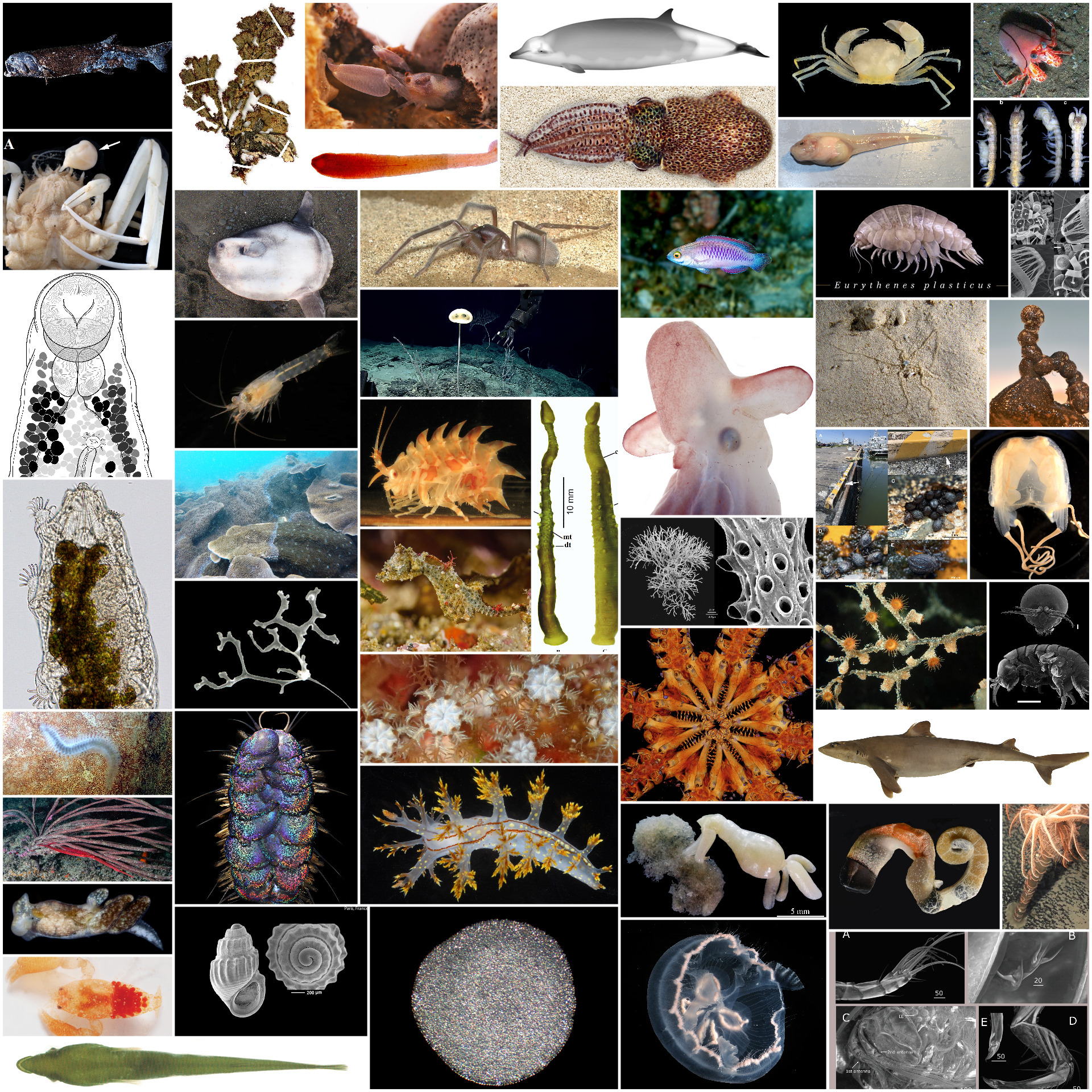Publication date: December 1st 2022

The World Register of Marine Species has continued to grow and has improved its content on different levels since its inception in 2007. Back in November 2017 - in honor of our tenth anniversary - an article was published in The Conversation, making stock of what we already know about marine biodiversity, based on the content of WoRMS.
Over the last five years - since our 10th anniversary - the content of WoRMS continues to grow with an overall average of 2,050 newly described marine species per year. To highlight some extraordinary new species, the Data Management Team (DMT) and a group of volunteers from within the Editorial Board and Steering Committee have been publishing a yearly press release ‘Ten remarkable new marine species from YYYY’ on March 19th, known as Taxonomist Appreciation Day. The WoRMS ‘Top 10’ is explicitly launched annually on this day, as it is only through the work of taxonomists that WoRMS can continue to exist. The annual ‘Top 10’ raises awareness of the stories behind a small selection of peculiar, funny or remarkable species described in a given year. Doing so also highlights the fact that there are >2000 marine species described each year and brings the fascinating science of taxonomy into the spotlight.

Photo compilation of the WoRMS Top 10 marine species. Photo credits for 2017, 2018, 2019, 2020 and 2021.
How many marine species are currently documented?
The attentive reader and user of WoRMS might notice something possibly strange with our statistics: the WoRMS marine species-counter was at about 242,000 on our tenth anniversary in 2017, and now in 2022, it is at 241,000… Did we lose or delete species? No, absolutely not. What has happened however is a major update on the content related to the environment information. And how does this explain the difference in numbers? WoRMS is about marine species, whereas over the years, also many non-marine species have been added to Aphia, the infrastructure behind WoRMS. In 2019, the Data Management Team - together with the editors - undertook a major action to update the environment flags, leading to about 13,000 species no longer being included in the marine species count. Retrospectively, we can derive that the marine species count in 2017 was actually closer to 229,000. Taking this into account, it is easy to understand that our knowledge of the number of described marine species has continued to grow over the last five years, and we can now more accurately put a number to this.
Rate of marine species descriptions
Since 1758, when Linnaeus published the 10th edition of his Systema Naturae in which he introduced the binomial nomenclature for animals, thereby marking the starting point of zoological nomenclature, there has been an overall average annual discovery rate of 1,255 species per year. Using data in WoRMS, we can also demonstrate that this rate of species discovery has not yet reached an asymptote, as over the last 15 years (2007-2021), the yearly average of newly described species is more than 2,200 per year.
Looking in more detail at this overall marine species description rate as documented within WoRMS, we know that the number of marine species described per year - since 1950 - has been at least 1,250 species per year. An absolute maximum number of marine species descriptions was reached in 1977, when 3,695 new marine species were introduced to science, (reaching almost 4,300 when fossil species descriptions are taken into account). A single publication published in 1977 - (consisting of 3 parts and 1,078 pages) described 1,720 new marine species of Foraminifera, explaining the extremely high number of new species for that year. The author of this work, Dr. Irene McCulloch, was not only both a teacher and a researcher, she was also a world authority on forams. Irene's influence was pivotal in the establishment of the Allan Hancock Foundation for Marine Research in 1938, and she left a major legacy within the field of marine science on the microscopic level. With her effort - which took 25 years to finalize - she also circumpasses Linnaeus himself for the ‘most described species within a single publication’. Currently for Linnaeus, there are 1,239 marine species in WoRMS from his Systema Naturae edition of 1758. Publications describing such a large number of new marine species are extremely rare. Within WoRMS, only 2 references contain more than 1,000 new species descriptions: Linnaeus, 1758 and McCulloch, 1977. Seven references are currently known to contain between 500 and 1,000 newly described species, of which six pre-date 1940. Curiously enough, the seventh publication in this list is also by Irene McCulloch, where she introduces an additional 518 marine Foraminifera species new to science!

From left to right: Carl Linnaeus, by Alexander Roslin, 1775 (oil on canvas, Gripsholm Castle), Nationalmuseum (Source) - Front page of Linnaeus, 1758 (Source) - Dr. Irene A. McCulloch in the Expedition Room of the Hancock Library (photo by Joseph Lingrey) (Source) - Front page of McCulloch, 1977 (Source).
The rate of species discovery is still high, considering that taxonomy as we know it - with the Linnean bi-nomen - began in 1758. The fact that this rate does not yet seem to have reached an asymptote, based on current WoRMS data, can have multiple explanations. One of them being the active number of taxonomists, and the fact that there are many more species to describe. The development of new techniques to discover and detect species is progressing fast, and the needed time to describe a new marine species cannot be underestimated either. Publishing on a new marine species is one thing, widely sharing this knowledge and information through WoRMS is a next step in the process of FAIR (Findable, Accessible, Interoperable & Reproducible) and open data, which is made possible thanks to the efforts of our many editors over the last 15 years. It is their voluntary contributions that have enabled us to accurately document the rate of marine species descriptions, to make these data freely and openly available and to use these data to test hypotheses based both on science and curiosity.
So, what kind of species are still being discovered?
This is of course an open question, dependent on the time-period you are investigating. Looking at WoRMS data for the species discoveries of the last five years (2018-2022) shows that the most commonly described species in that period is a currently living (=Recent) marine gastropod, with gastropods representing on average 28% of all species descriptions in any given year between 2018 and 2022. Newly described marine gastropods are followed closely by newly described Crustacean species (21%). This does not come as a big surprise: this can likely be explained by the proportions of those species that exist in nature, as these are simply the most speciose groups.
And these findings have made the DMT curious: If there is such a clear spotlight on particular species groups over the last 5 years, has this also been the case throughout history? Or are there major differences over time, and what could be the driving forces for this? The DMT will explore this further, but we are open to any suggestions or thoughts on this matter from a wider community and perspective…
References:
Contact
WoRMS Data Management Team - info@marinespecies.org
Acknowledgements:
This celebration and series of news messages initiated by the Data Management Team (DMT) would not have been possible without the collaboration of the WoRMS Steering Committee (SC) & voluntary contributions by many of the WoRMS editors.
The work of the DMT and many WoRMS-DMT-related activities are supported by LifeWatch Belgium, part of the E-Science European LifeWatch Infrastructure for Biodiversity and Ecosystem Research. LifeWatch is a distributed virtual laboratory, which is used for different aspects of biodiversity research. The Species Information Backbone of LifeWatch aims at bringing together taxonomic and species-related data and at filling the gaps in our knowledge. In addition, it gives support to taxonomic experts by providing them logistic and financial support for the organization of meetings and workshops related to expanding the content and enhancing the quality of taxonomic databases.
WoRMS – as ABC WoRMS – is an endorsed action under the UN Ocean Decade.



